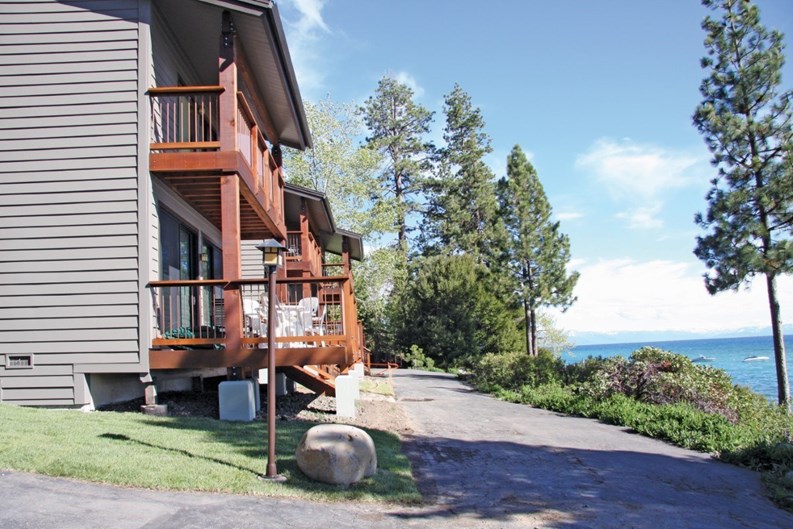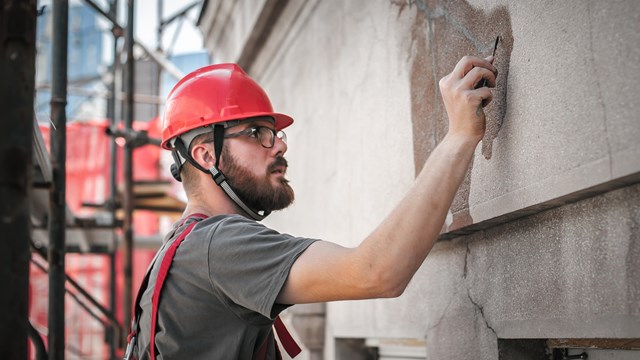When a condo’s fencing, decking or siding wear out and need replacement, smart condos are looking well beyond “apple-for-apple” replacement materials.
Wood siding, a favorite for decades, is frequently being replaced by vinyl siding or even fiber cement, both of which can mimic the look of wood. When wood decks fail, lumber is beingreplaced by a variety of composite materials. And in fencing, failing wood is steadily being replaced by PVC (polyvinyl chloride).
Because decks, fences and siding have to be replaced so often, condos that utilize newer materials that need less maintenance can realize considerable savings over time – a key feature in these penny-pinching times.
Fenced In
There are four kinds of fencing generally used by community associations: chain-link, wood, PVC and ornamental. Chain-link is cheaper thanwood, which is cheaper than PVC. Ornamental fences, the priciest of all, are usually made of expensive metals like wrought iron, aluminum or steel.
Chain-link is the way to go when the primary purpose is security. Placed around the entire perimeter of a property, the tennis court or swimming pool area, chain-link does the job, but is not exactly the most attractive option.
Inexpensive, attractive, and reliable, wood has traditionally been the fence of choice – but this is changing.
“We’re seeing more and more PVC fencing in condo properties that had wood fences, especially in areas like Chestnut Hill, Brookline and Newton,” says Bill Taylor, project manager with Premier Fence in Avon, Massachusetts. The reason, Taylor says, is the desire to reduce maintenance costs to virtually zero with PVC. “You're seeing a lot of wood being replaced with vinyl because of the value for the buck... Homeowners are not looking for maintenance, they want low maintenance – something that’s going to last a lifetime. They don’t have to worry about rotting out. It (PVC) doesn't have to be maintained [painted] with color; it’s alreadycolorized.”
PVC, short for polyvinyl chloride, is impervious to water damage and mold. It lasts far longer than wood – so long, in fact, that PVC fencing generally comes with a lifetime guarantee. PVC doesn’t need to be painted, just power-washed every few years, and it doesn’t splinter. In the past, the relatively steep price of the material made PVC fencing prohibitively expensive, but theprofessionals say that’s not really the case anymore as its cost has dropped to about 25 percent more than wood.
Earlier problems with PVC fencing not holding its color have been mostly solved in today’s quality products, says Taylor. “It’s not an issue with the brand that we carry, but with some of the lesser-quality products it’s still an issue.” When buying a PVC fence it’s good toknow a little bit about the company that you’re dealing with.
Side of the Times
Alan Mooney, RS, president of Criterium Engineers in Portland, Maine, says condos looking at replacement siding have a number of options:traditional wood, vinyl, composite-based vinyl, cement and synthetic stucco, or EIFS (Exterior Insulation and Finish Systems).
From an economic standpoint, vinylsiding is the least expensive to install and maintain, Mooney says, and it does “a really good job of providing a weather-tight envelope.” For condos that want a wood-like appearance without the ongoing maintenance cost of wood, Mooney recommends composite-based vinyl siding or fiber cement materials like HardiePlank, both of which are manufactured with a simulated wood grain pattern.
Fiber cement siding still needs to be painted, like wood, but it lasts longer, isn’t damaged by water, and needs very little maintenance. However, fibercement does cost about three times as much as conventional vinyl siding.
If a condominium is in a historic district and cannot change its existing wooden siding, or it just wants to retain its heritage, Mooney says sticking with wood “is a good idea if it’s important to the building architectureand the value of the building.”
However, Mooney warns that wood siding needs extra preparation before it’s installed. “Make sure that it’s been treated, back-primed, treated with some kind of wood preservative – and that should be done on all sides and all ends of the material before it’s put on, and that is going to maximize the life. And, of course, have a good maintenance program going forward.”
Synthetic stucco or Exterior Insulation and Finish Systems had a checkered history because of installation problems that occurred decades ago but those problems have since been solved, says Mooney. “It has a bad reputation because of the problems that occurred 10 to 15 years ago, but if you do it right today, you end up with a perfectly good product. And there area lot of buildings being built with it.”
Important in the installation of EIFS, and any other manufactured material is that the contractor is certified to install the particular product, says Mooney. “If you’re using a material that the manufacturer does train and certify installers, by all means check for this. You also check that it’s a current certification, and that the crewworking on your project is actually the crew that was certified by the company. You really have to check the details because that company may have five different crews and in only one of them has actually been trained and certified [for the product].”
On Deck
Wood still dominates as the materialof choice for decks, but many condos are choosing a variety of composite lumber alternatives, which contain a combination of [fine particle] wood with polymers or plastics.
The Trex brand is an industry standard in composite, but Veranda, Trimax and Deck Lok are also well-respected. Their consistency of color and shape, uniformity and durability, along with their lack of maintenance requirements, make them a good choice for condos. Composites are considerably more costly than wood, but can last decades with almost no maintenance if properly installed.
When installing composites, it’s a good practice to use hidden screws instead of a top-fastening screw. Hidden screws make it much harder for water to penetrate the board and cause failure.
Another common failing in deck construction is surface tilt sending water the wrong way – on an incline toward the condo – which allows water to accumulate on the decking. When installing a deck, close attention needsto be paid to the footers, experts say. Footers that are placed deep into the ground will resist being pushed by frost heaves, and won’t tilt the deck into the building.
Another synthetic option for decking is mineral-added HDPE [high-density polyethylene] plastic lumber. Made from 100 percent recycled materials, no trees are destroyed to manufacture this product, and it releases no toxic chemicals or greenhouse gases into the environment. Plastic is typically softer than wood or wood-composites, however, and is susceptible to expansion and contraction from variable temperatures. To compensate, some manufacturers add recycled materials and minerals. Tangent Technologies and EPS are major manufacturers.
When a condo is looking at alternatives to its existing materials, it’s important that the association work closely with a good engineering or reserve firm to carefully look at the cost and benefits of any material over a number of years. By using due diligence when choosing newer materials, a condo can minimize maintenance while maximizing value for its owners.
Jim Douglass is managing editor of New England Condominium magazine. Freelance writer Keith Loria contributed to this report.







Leave a Comment